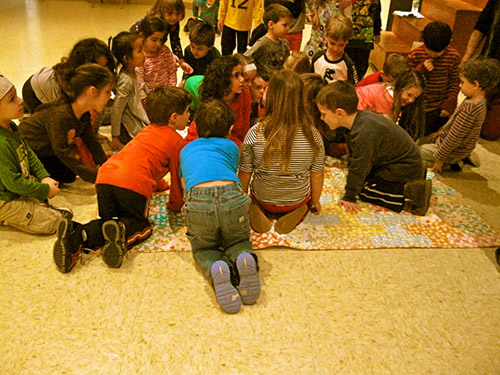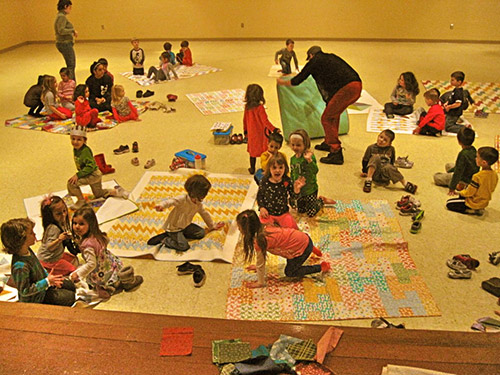The other day, in honor of Q week in Bee’s pre-K class, I was asked to come by and show a few of my quilts to the kids and maybe tell them a little about quilts. I don’t think the teachers quite knew what they were getting themselves into. No, no, I didn’t launch into an academic lecture on Modernism for four-year-olds; I just brought just about every quilt in the house (except the book quilts).
We started off with Bee explaining the origins of the U.R.N.H. quilt, the one I made after Bee and I took a walk and she pointed out that our shadow, when we held hands, made an H. Kids and adults alike seemed amazed by the depth of meaning and understanding that was evident in Bee’s eyes and smile. And with the realization that things can matter came another realization for Bee, that sharing, then, is a profoundly meaningful act and not just a social nicety.

Bee wanted to share the love she has for her H quilt, and the love that flows through that quilt, and then she invited every kid to come sit on her quilt, her very most favorite thing. After that the rest of the quilts came out: play mats for Baby Rabbit, queen-sized quilts from our bed, and magazine-cover quilts alike. The teachers were horror-stricken at first, seeing dozens of kids crawling all over some of more intricate quilts, but that is precisely the point for me: quilts are meant to be loved, and that is what Bee understands so well. In fact she spent much of her time making sure each of her classmates had the chance to be fully wrapped-up in a quilt–what we call a quilt hug. In those first moments, Bee intuited that quilts are about so much more than being warm.

This is why I find it so offensive when anyone denigrates the motive or meanings of another quilter, when someone dismisses the practice of another maker. Such acts, whether they are based on the belief that one person’s stylistic choices are existentially superior to another’s or the assumption that certain processes, approaches, or perspectives are appropriate or not, simply ignore the fundamental humanity of each and every maker–and in doing so, they forget the essence of quilts themselves. I am still feeling rather wounded by some of the recent events surrounding a controversial quilt (I shan’t rehash that here), but Bee’s intuitive grasp of the essential meaning and value of quilts, and her generosity in sharing that understanding, has gone a long way towards healing some of that hurt.
For all of these reasons and more, the choice to make is fundamentally a political act to me; it is a choice to not buy, to step outside the space of commodity and disposability. Making is an investment of self, of emotion and intellect, belief and perspective. It is an explicit decision to fill my life with things that matter symbolically and materially, and as such it seems only natural to imbue them with my most deeply felt views.
This is why I find it hard to separate my quilts from my political and social views. Quilting is a part of my world and a reflection of my worldview; I do not see them just as pretty things. It is not simply something I do, a job or a hobby; it is a profound form of meaning-making. The quilts, in myriad ways and to greater and lesser degrees, map my aspirations and beliefs; writ large, they present a world for Bee, one that on this day I truly was able to share.
Quilts matter; I truly believe that, but there is nothing better than seeing that fact dawn upon your four-year-old daughter in front of gaggle of children, and for that realization to then spread across the room. This day is the epitome of the future I hope to build; it is the essence of why I make quilts.
-t









11 Responses to What children know about quilts (and we should too)…